Models injured by bullets
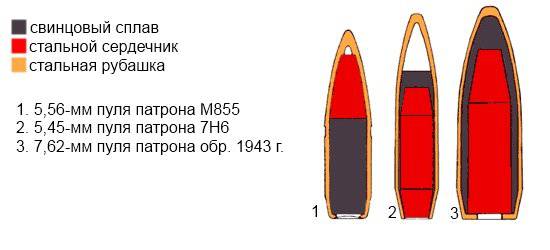 The beginning of the modernization of small weapons in this regard, refers to the 1963-64, when the USA adopted the 5,56-mm M193 cartridge for the M16-1 rifle. In 1980, an improved М16А2 rifle and 5,56-mm М855 cartridge with a bullet of increased punching action were adopted in the USA. Following the United States, the transition to 5,56 mm weapons occurred in Germany, Italy, Israel, etc. In 1974, in line with the general trend of modernization of small arms in the USSR, the 5,45-mm cartridge 7H6 for the AK74 machine gun was adopted.
The beginning of the modernization of small weapons in this regard, refers to the 1963-64, when the USA adopted the 5,56-mm M193 cartridge for the M16-1 rifle. In 1980, an improved М16А2 rifle and 5,56-mm М855 cartridge with a bullet of increased punching action were adopted in the USA. Following the United States, the transition to 5,56 mm weapons occurred in Germany, Italy, Israel, etc. In 1974, in line with the general trend of modernization of small arms in the USSR, the 5,45-mm cartridge 7H6 for the AK74 machine gun was adopted.7,62x39 mm The Soviet cartridge has a spindle-shaped bullet with an all-metal sheath that has a copper-coated steel jacket, a large steel core, and a small amount of lead in the nose and covering the core (Figure 1). In a tissue, this bullet usually passes 26 cm straight before starting to deviate. As a rule, the canal through the abdominal cavity caused minimal damage; the canal in the organs was similar to those produced by the non-expansive gun bullets. A moderate hip injury to the thigh with a 7,62x39 mm bullet was similar to that inflicted by low-powered pistol bullets: a small dotted inlet and outlet with minimal destruction of muscle tissue.
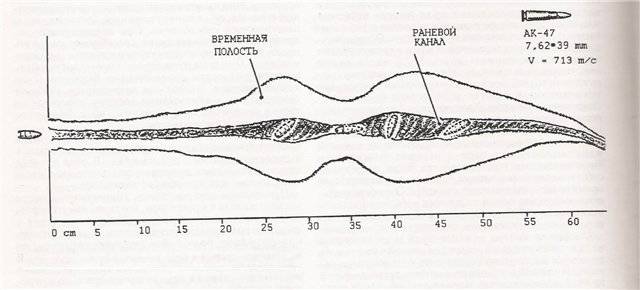
7,62x39 mm Yugoslav ammunition - have a bullet with an all-metal sheath, with a lead core and a flat base. Usually, only the first 9 cm is moved in a straight line before the deviation. Due to the lead core, the direct bullet deviates, several small flattened fragments fly away from it, but this does not seem to be essential for injury.
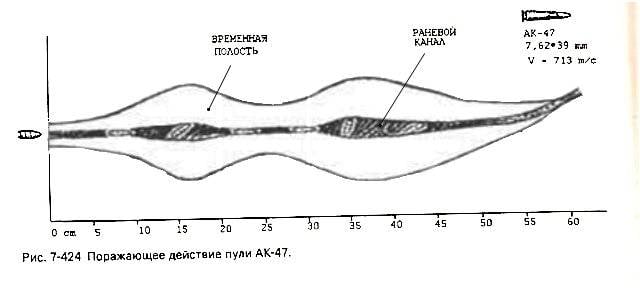
In most cases, it goes to the side with a wound to the abdomen. One can expect a three times larger area of tissue damage than after passing a bullet in a straight line. In addition to the larger bullet channel in the organ formed by a bullet with a deviating path, the tissue surrounding the channel was stretched from the temporary cavity. The actual damage from stretching by cavitation could differ from a practically explosive effect, extensively affecting dense organs, such as the liver, to a single bullet channel when the bullet passed through the cavities. In the second case, there was almost no effect when a small amount of liquid or air flew from the hollow organs (for example, the intestine) into the outlet. The exit wound hole could be point or elongated, depending on the orientation of the bullet. The exit hole could be stellate if the bullet had significant potential. The entrance wounds of the thigh are represented by small pinholes, but the output is likely to be stellate, when measured over 11 cm from opposite edges. These stellate injuries mainly cause bleeding from very small vessels, to medium-sized vessels, but the temporary cavity stimulates the muscles of the vessels, allowing the latter to constrict to limit blood loss. Being wide open, these injuries tend to dry out and have an amazing healing rate even in situations of limited medical care. Such deep destruction of the leg tissue, of course, temporarily limits the mobility of the unfortunate.
5,45x39 mm. The bullet has an all-metal sheath of copper-plated steel and a massive steel core, similar to the core of its predecessor, bullet cartridge 7,62x39 mm. A unique feature of the bullet cartridge 5,45x39 mm is an air cavity located inside the shell in the bow. The assumptions that the air cavity contributes to the deformation and fragmentation of the bullet have not been proven, but the air cavity provided a shift of the center of mass to the base of the bullet, which contributed to its very early deflection. In addition, when colliding with a cloth, lead, located behind the bullet cavity, was shifted back. It caused asymmetry and, possibly, was the cause of a peculiar curvature of the bullet's trajectory in the second half of the way. The trajectory curve is evident only in a long wound channel, for example, when an oblique shot in the body. In fact, it does not have any significant wound effect, but can cause a confusing wound channel in the tissue. This bullet deviates only after 7 cm penetration into the tissue, providing an increase in damage from stretching the temporary cavity in a larger percentage of edge hits; other bullets need a deeper penetration into the fabric to start deflecting, and in many cases cause minimal damage during edge hits.
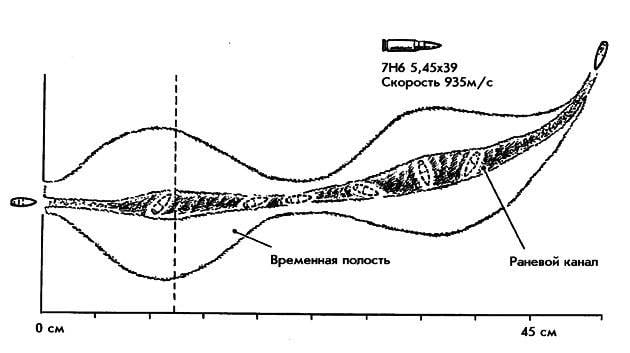
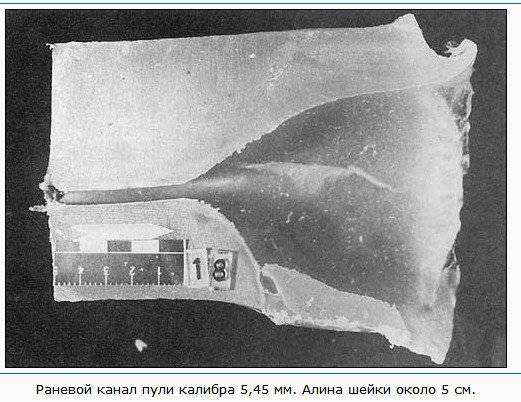
Hip injury 5,45 mm bullet cartridge 7H6. Bullet fracture femur. In the area of the fracture is a characteristic triangular fragment of the bullet nose.
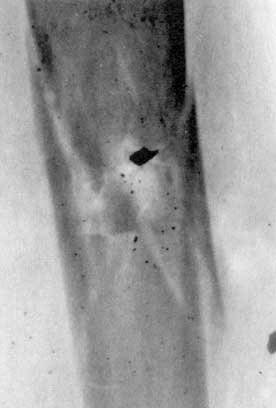
5,56x45 mm. When hit, a large wound cavity is formed. As shown in the wound profile, this all-metal bullet follows a straight 12 trajectory of cm, then deviates by 90 degrees, flattens and breaks the bezel (cutout around the middle part of the bullet with which it is reinforced in the sleeve). The bullet flattens, but one piece remains, containing 60% of the total mass. The back is broken into many fragments that penetrate 7 cm radially from the bullet channel. The temporary cavity is stretched, its effect, which has increased due to penetration, weakens due to fragments that cause many extensions of the wound cavity.
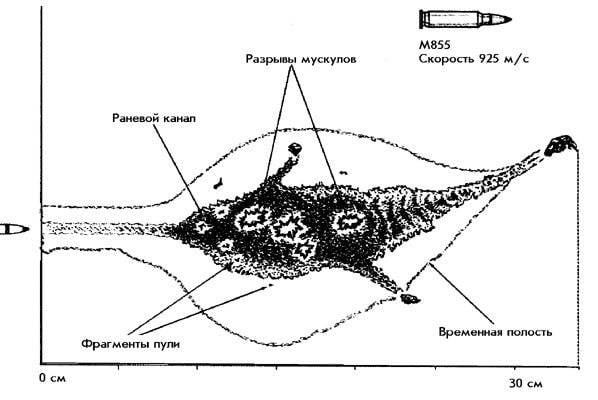
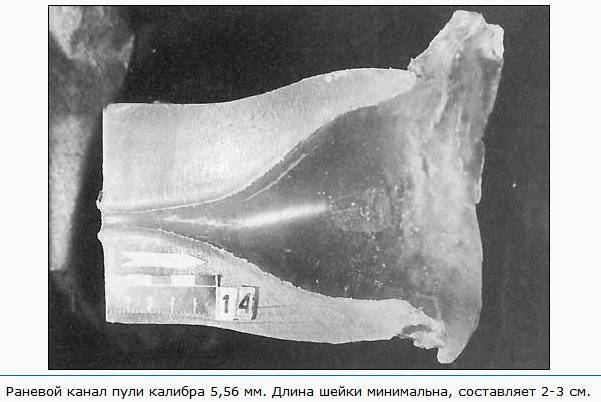
The effects of such bullets in the wounds of the abdominal cavity demonstrate the variable cavity described for the Yugoslav bullet for AK-47, moreover, the damage increases, due to muscle breaks and fragmentation. When searching for a channel comparable to the size of a bullet in hollow organs, such as the intestines, a channel was always found left by an injured tissue that was more than 7 cm in diameter. The inlet for wounding the thigh was small and pointed. The first part of the bullet channel showed minimal damage. The exit hole was different from the pinhole described for the bullet from the Soviet cartridge 7,62X39 mm, it was stellate, like the wound of the Yugoslav bullet 7,62x39 mm. The size of the outlet depended on the thickness of the hip, which fell. In considerable thickness of the thigh, the fragmentation of the M193 bullet also led to great tissue damage with one or several small outlets located near one large.
Hip injuries 5,56-mm bullet cartridge M855. Bullet fracture femur. In the area of the fracture, numerous fragments of a fragmented bullet.
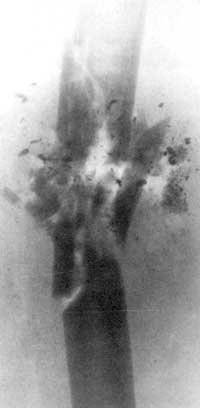
1 - A bullet fracture of the middle third of the tibia with a 7,62 caliber. There is a deviation from the initial direction of movement of the bullet.
2 - A bullet fracture of the middle third of the tibia with a 5,56 caliber. There is a complete fragmentation (destruction) of the bullet.
3 - A bullet fracture of the middle third of the tibia with a 5,45 caliber. There is a otlom bullet nozzle.
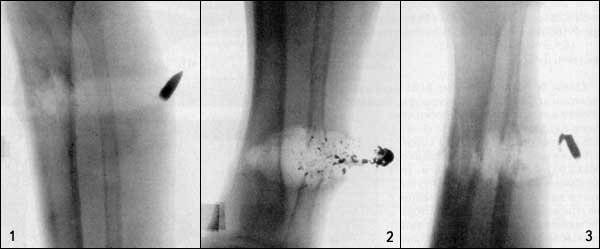
The degree of fragmentation decreases with increasing firing distance (the collision rate decreases), as shown in Figure 7. At a distance of about 100 meters, the bullet breaks at the rim level, forming two large fragments, and at a distance of shooting 200 meters no large fragments form, although the deformation persists up to 400 meters. These changes in deformation / fragmentation are important for forensic experts. They can use a bullet to assess the firing distance, which, having entered the body, pierced only soft tissues.
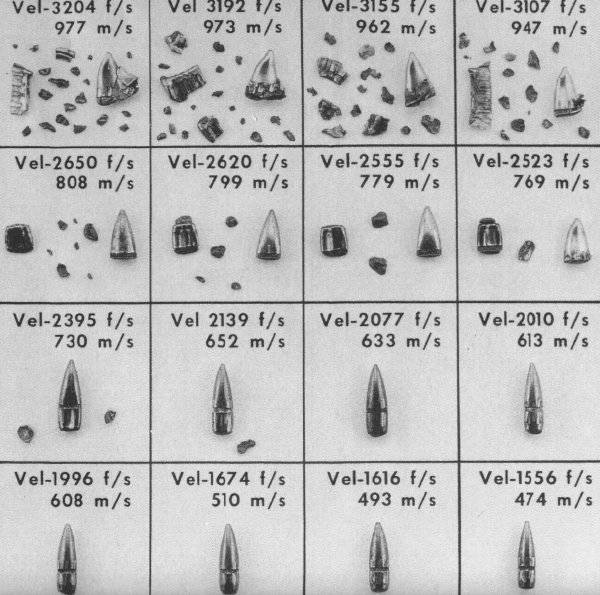
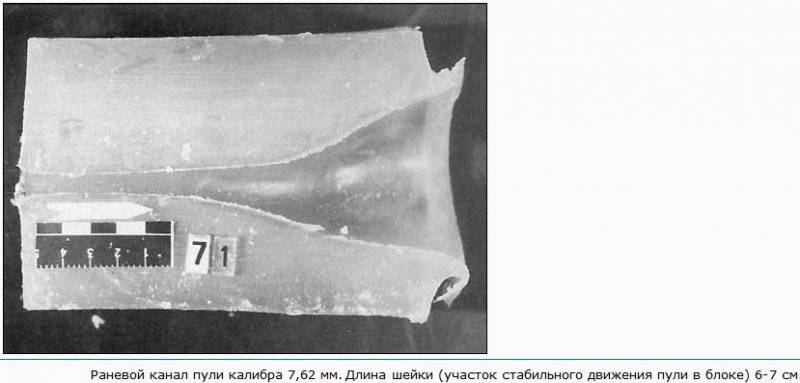
Information